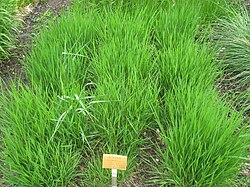| Beckmannia eruciformis | |
|---|---|
 | |
| Scientific classification | |
| Kingdom: | Plantae |
| Clade: | Tracheophytes |
| Clade: | Angiosperms |
| Clade: | Monocots |
| Clade: | Commelinids |
| Order: | Poales |
| Family: | Poaceae |
| Subfamily: | Pooideae |
| Genus: | Beckmannia |
| Species: | B. eruciformis |
| Binomial name | |
| Beckmannia eruciformis | |
Wikimedia Commons has media related to Beckmannia eruciformis .
Beckmannia eruciformis, the European slough-grass [1] or slough grass, is an annual or short lived perennial in the grass family, Poaceae, found in shallow marshes or sloughs, and used for animal fodder and forage.